It was only a matter of time…
The B Action Movie Thread has been a gargantuan mainstay of this site for several years. So, in our continued efforts to dominate the internet in every conceivable way, here is a weekly column. A digest, if you will. Dig in and we’ll see you in the thread!
THIS WEEK ON THE B ACTION MOVIE THREAD (Last Week’s Installment)
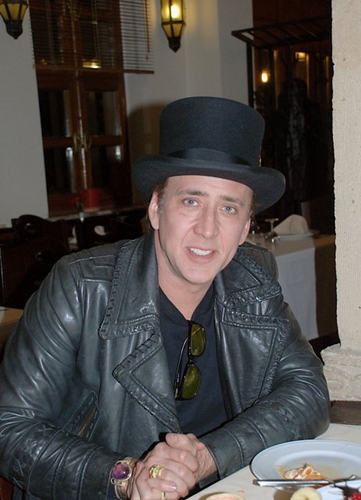
Erix here… with your weekly thread recap spanning page 1397 to 1401.
We start the week off in fine form, as Hans Gruber’s EYE CONDITION! is making his way through the 4th season of Miami Vice, and he is not too pleased by the rocky start. This leads to a discussion of that landmark series and favorite uses of music. There’s some choice YouTube embeds that are worth checking out.
The highlight of this discussion is Paul McCartney’s much welcome return to the thread, as he lists his Top 5 episodes…
1) ONE-WAY TICKET – this one “tickets” all the boxes (heh), and has the most outstanding song/montage of the series: Pete Townshend’s “Face the Face”, as the dad from Home Alone broodingly flies a plane, intercut with Crockett broodingly using a firing range. Bonus points for the parts where Crockett does dives and rolls to avoid the targets “shooting back” at him. He clearly doesn’t understand that they’re just cardboard targets and will not hurt him!
2) THE PRODIGAL SON – a movie-length, and movie-quality, extravaganza. Surreal and exciting. Jan Hammer’s “New York Theme” is his most outstanding VICE work.
3) SMUGGLER’S BLUES – I love how it jumps from plot to plot with no real throughline. Just like real life! Tubbs’ only real heroic moment in the series, when he is forced to make a snap decision to save Crockett’s and Trudy’s lives, gives me chills!
4) MADE FOR EACH OTHER – a colourful, good-natured comedy episode with my two favourite characters, Zito & Switek! I would happily watch an entire show like this! Very touching scene where Crockett invites a vulnerable Zito for a night of passion aboard his houseboat.
5) GIVE A LITTLE, TAKE A LITTLE – I love Switek’s standup comedy routine, and Zito’s intense laughter at it.
Moltisanti presents us with the trailer for Triple H’s new film – THE CHAPERONE.
Needless to say, we are not amused.
Moltisanti’s festival of bad trailers continues with Son Of No One.
He also has this to say:
Don’t know whose mustache is shittier, Pacino’s or Channing Tatum’s. Pacino should have ditched the stache and kept his bitchin’ Kevorkian look. Love the dramatic look on Tracy Morgan’s face when his credit comes up. He’s really trying to stretch himself here.
Page 1398 features discussion on Blind Fury and Fortress. Focusing on these great films is always welcome.
Twitch Reflex presents us with the closest thing we’ll ever get to a Road House-themed restaurant.
Needless to say, we call POPPYCOCK on Sly getting yet another Razzie nom for The Expendables. And we have varying ways of expressing this…
But duke fleed needs to go on record:
Forget the, Razzies, Stallone should be nominated for…Best Director at, The Academy Awards. The Expendables should also get a…Best Picture nomination. Instead, some weak films will be nominated and win.
He doesn’t necessarily speak for all of us, but how can you not quote that?
Moving right along, Tyler Foster has this to say about The Mechanic:
I don’t think there’s an audience member in the world that doesn’t understand at this point that professional assassins methodically and emotionlessly listen to classical records in fancy houses and don’t have real friends other than business associates and goofy friendly nobodies to whom they have indicated their dream of owning a boat.
Also on page 1399… HunterTarantino and Rene with the shocking reveal that they have watched several bad movies in theaters. And liked them!
Felix posts a link to an interview with cinematographer Marc Windon (Command Performace) where he talks about his experiences working with Dolph Lundgren and shooting low budget action films in Bulgaria.
HunterTarantino watches The Blue Iguana. And, based on his comments, we all should follow suit.
To give you an idea of what kind of movie it is, the opening sequence involves Dylan McDermott chasing down a baby snatcher/salesman, who then manages to try and escape by hiding on a freighter boat. McDermott promptly shoots the cable he’s clinging to as he plunges into the ocean to his death. We know this because he screams extravagantly, “IIIIIIIIIIIIIIIIIIIIIIIIIIII CANNNNNNNNNNNNNNN’T SWWWIMMMMMMMMMMMMMM!!!!!!!!!!!!!!” And then Dean Stockwell and his neck brace show him to beat him, and he and his equally corrupt female partner give Dylan a new assignment in an alleyway using a projector to show him slides, no plausible electrical outlets be damned.
We wrap things up with some pretty good John Woo talk and Felix gets to make post # 70,000 – quite a milestone. He marks the occasion by asking the question on everyone’s mind… What was Anthony Hopkins doing in Mission: Impossible 2?
And we leave you now with this selection of audio outtakes from a thread favorite…. Ernie Anderson – The Voice of ABC.
THE MIND OF RENE F. RANGEL
“Barbara Carerra was in Lone Wolf McQuade. There’s a scene where she and Norris are romping on the ground with a water hose in slow motion.”
“Watching The Pest right now. This movie is TERRIBLE. It’s a train wreck that I’m enjoying for that fact. … Leguizamo does shoot a tiny revolver that has about 6 tiny bullets in it. That was funny. … So yeah, I think the movie is about a 3 to a 4″
“I remember falling asleep during The Two Towers because I had just started working at McDonalds, and I had just gotten off of my shift, and my uncle invited me to see it with my cousins, and the combination of being tired and just not being interested in the movie led me to catch some zzzz’s. The Return Of The King was a different story. That one was pretty cool.”
“Heath Ledger (and Bill Fichtner and Eric Roberts) are the only great things that I take out of The Dark Knight. … I still remember both myself and my girlfriend being really let down by the movie after seeing it. I saw it 3 times in the theater … and each time I still felt the same way.”
THIS WEEK’S MOVIE
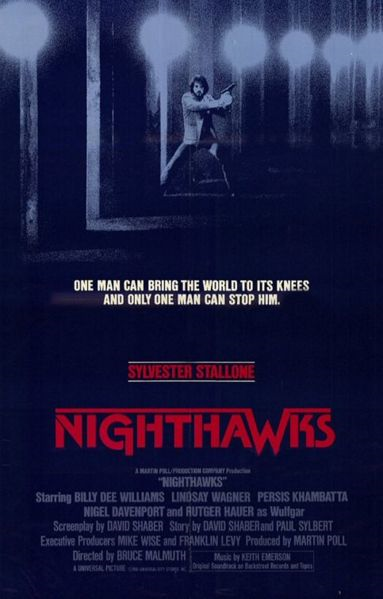
RENE LOVES NIGHTHAWKS
Nighthawks is an amazing piece of cinema. I remember first seeing it back in the mid 90’s on TBS and liking that it was something by Stallone that I was unfamiliar with. Actually, most of his 80’s catalog I hadn’t seen yet, so I hadn’t bared witness to the greatness that is Rhinestone.
What really sets Nighthawks apart is that it really isn’t B-Action so much as it’s a tense thriller. Tense thriller wasn’t something that you would associate with Stallone back then. He was Rocky. That’s all he was. He was still a year away from the other defining character that he would do, Rambo, so he was trying to reach out and do something different. I really admire that about Stallone. I really admire actors who take chances in films that they wouldn’t normally do, (Like Rhinestone) and this movie was a far cry from his feel good performance as a down on his luck boxer who gets a shot at the title.
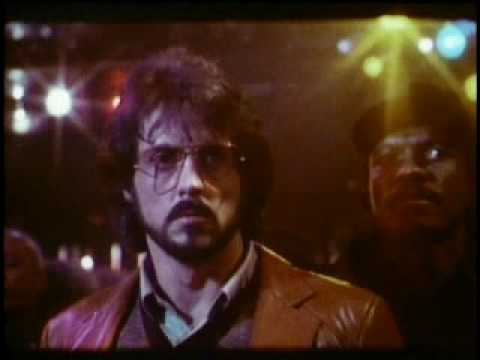
In Nighthawks he plays DEKE DASILVA (That is such an awesome name). He’s one half of a special team that uses unusual tactics to nab criminals. In the opening scene, Stallone pretends to be a nurse walking home, and several thugs try to nab his purse, only to feel the full weight that is in his purse when he starts swinging it around and knocking teeth out. I still remember the first time I saw it, and not immediately realizing that it was Stallone in a really bad mask.
DaSilva’s partner is named Matt Fox, and he’s played by Billy Dee Williams. Also known as that guy who was charging $40 for his autograph when I went to the Austin Comic Con last November. He had all this Star Wars crap, since sadly that’s what he’s best known for, and if he would have been charging even $20, I would have gladly taken my Nighthawks dvd so he could sign it. I wonder if he would have been happy about that? Somebody bringing him something different for a change. I know Ernie Hudson was happy when I gave him my Leviathan dvd to sign. Man, he’s a class act all the way.
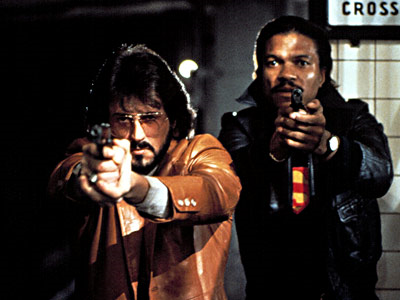
Anyway, Billy Dee is Stallone’s partner, and they get put in a terrorist task force lead by Nigel Davenport. It seems a terrorist known only as Wulfgar has entered the United States, and has chosen New York as his base of operations. It’s up to Stallone and Billy Dee to take him down. They’re also assisted by their crusty Lieutenant, Munafo, solidly played by Joe Spinell. This was a year after his breakthrough performance as the Manaic, Frank Zito. See Maniac, then see Nighthawks. It’s like watching a completely different person. He worked with Stallone on several films, and Nighthawks was their last collaboration. Damn sad to see that happen, as I would have loved to have seen Spinell show up in other Stallone films.
Wulfgar. First, that’s a great name. I bet when they created it, they were thinking that since he’s a terrorist, they wanted something close to Carlos The Jackal, and decided on Wulfgar. (My thought turns out to be right, as according to IMDB, Wulfgar was modeled after Carlos The Jackal) Wulfgar is played by Rutger Hauer in his first English language role, and he comes out swinging.
Wulfgar is one nasty piece of work. He charms a young girl who sells perfume, leaves a bomb near her station, and calmly walks out of the department store, which then blows up. He shoots a Mac-10 through a guitar (Why has Robert Rodriguez not done this yet?) and the only female that he trusts is Persis Khambatta’s Shakka Holland. Also known as the living vessel for V’ger or that bald girl from the first Star Trek movie. She’s about as ruthless as he is. Hauer starts off the film with a prosthetic nose and a beard, has plastic surgery, then he turns into the Dutchman that we all knew back then.
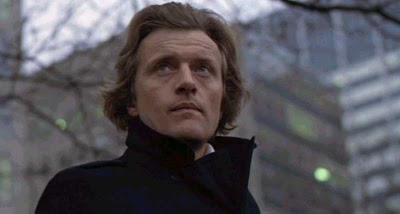
He immediately sets up a lady contact in New York, even telling her that he’s an international terrorist, which she laughs off. (I think in this day and age, the lady would have immediately called Homeland Security) and sets about doing his destruction.
The movie is full of tense moments. Lots of them. The best being the nightclub sequence, where Stallone, who has nothing to go on but a drawing of Wulfgar as he might look like if he had plastic surgery, that he doodled during a conference with Davenport, sees a man who he believes to be Wulfgar, and yells out his name, after which a shoot out occurs, and a chase through the streets, and into the subway system.
The climax to this chase is also memorable… Wulfgar cuts Billy Dee’s cheek, and gets away, with Stallone holding Billy Dee’s face and yelling “YER FUCKIN’ DEAD! YER FUCKIN’ DEEEAAADDD!!!” at the top of his lungs.
(I never knew this, but The Rolling Stones song “Brown Sugar” is played during the disco dance club sequence. It wasn’t until recently that I discovered this, as the Universal dvd that I have doesn’t have that song. Credit to Mike for telling me that the old Good Times dvd release has the song, but it’s a full screen dvd.)
It’s just great to get this little known movie of Stallone’s on dvd at all. Just the fact that Universal put the money out to re-release it, and in an anamorphic transfer. It’s nice to know that they haven’t completely dismissed it. Looking through Sly’s catalog, Nighthawks is something that’s not mentioned often. I wouldn’t know why not. It’s a stellar piece of cinema that is unjustly forgotten when talking about his great performances. Nighthawks was Stallone’s French Connection. He’s Popeye Doyle, and Rutger Hauer’s Wulfgar is Frog 1. (I’m not to far off on this, as according to IMDB, Nighthawks started out as French Connection III that would have teamed up Gene Hackman with Richard Pryor(!) )
Bruce Malmuth has a great solo directorial debut (his previous film was a collaboration) with Nighthawks. He shows that he can bring lots of tension, and stage great shootouts. A shout out also has to go to Keith Emerson’s awesome score which is nothing less than “Groovy” and has some great synthesizer beats in it as well.
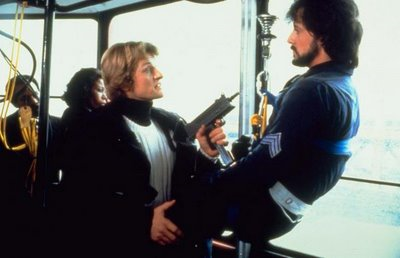
Stallone plays Deke DaSilva as a man determined to take down Wulfgar the terrorist. The entire last section of the movie is tense. Wulfgar and Shakka take a bunch of delegates hostage on a cable car, and Wulfgar demands that DaSilva go and speak with him. Wulfgar loves the game he’s playing with DaSilva. He goes so far as to point out that since DaSilva is hanging from a suspension cable while they are talking since he had to be raised up into the car, that Wulfgar could just cut the wire and send him down into the water. He won’t. He loves playing the game with DaSilva. The final sequence in the apartment of Lindsay Wagner’s character, Irene (DaSilva’s separated wife) is one for the books. I don’t want to spoil it for anyone who hasn’t seen Nighthawks, but let’s just say it’s got an image that should be iconic, and baffles me as to how it’s not a t-shirt, or an annoying internet meme. The scene also has a bloody death for Wulfgar that is obviously edited. I really hope that one day, the uncut death scene surfaces.
Nighthawks is an underrated gem and it continues to surprise me that a lot of people don’t really know it. It easily belongs in Stallone’s top 5 films of all time. When we’ve gotten sequels to Rocky and Rambo, and I’ve liked those films, the one other film I’ve always wanted Stallone to sequelize is Nighthawks. Ok, ok. Also Tango & Cash.
Random Trivia: Nighthawks is on the Now Playing display of a movie theater in the Lucio Fulci movie, The New York Ripper. It’s clearly seen as the police patrol 42nd Street.
Mike’s Take:
Ruthless.
That’s probably the best word I can use to describe Nighthawks. Written by David Shamber, Walter Hill’s colleague on The Warriors, Nighthawks is the first full-fledged action movie Sylvester Stallone ever made, and barring Cop Land and his first outings as Rocky and Rambo, it’s his best and the most uncompromising of his catalog. Seriously, when your protagonist’s name is Deke DaSilva, you’re teetering on the edge of it being a comedy. Luckily, Nighthawks is anything but that. Terrorism was starting to become a global issue when it came out (more on that later), and Giuliani was more than a decade away from cleaning up the streets.
For 1981, it’s a very nihilistic film. There’s several narrative turns the film takes that are quite jarring, and the motivations of the antagonists echo the route that Heath Ledger took as the Joker many years later. Wulfgar (a brilliant Rutger Hauer) and Shakka (Persis Khambatta with flowing hair hot off Star Trek: The Motion Picture) aren’t trying to preach a message like Al-Qaeda, they’re pleasure-seekers trying to live on their own, twisted American Dream.
Bruce Malmuth, director of the very unsatisfying Steven Seagal outing, Hard to Kill, directs; and his vision is in the same ballpark that Friedkin and Lumet played in so many times to an overwhelming success. Though Stallone has been on record that it was an arduous shoot, the action sequences are exquisitely tense and he fully encapsulates the spirit of a by-gone era for New York City. Sly got favorable comparisons to Pacino and De Niro when he first broke out, and though he’s more iconic as an action hero, Sly was more poised as an actor in that vein, and he’s brilliant here. DaSilva is different from a lot of Sly’s other cop personas in that he’s much more on the edge and tends to go by the books in his activities, even in the face of the Interpol agent with a no-holds-barred, kill-them-all ideology—something that just about all the big action names of the 80’s live and die by. Billy Dee Williams also shines as Matthew Fox (not the actor), Deke’s partner, not quite in the sort of Colt 45 swag he’d become synonymous with, but he gives it his all and succeeds.
How it isn’t thought of as something of a minor masterpiece or at least one of the more famous Stallone outings is tragic. And 30 years later, it’s still as frighteningly relevant as ever.
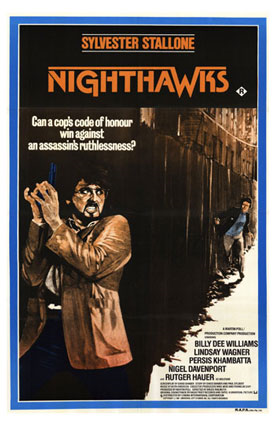
Erix sez:
I really like this one… It’s a bit of an odd duck.
From the gaudy opening credits (eye-shattering giant orange font on a black background, framed by Keith Emmerson’s Lalo Schiffrin pastiche) to the disco scene, to its stark portrayal of NY, it really feels very much like a holdover from the 70s. And I’ve always had a thing for that aesthetic. But the anachronistic feeling of the piece gives it an unintentionally surreal vibe that makes it sort of timeless.
Take, for example, what I like to call “The House Party On The Edge Of Forever” … Rutger Hauer’s villain is introduced (as Rene pointed out) blowing up a nice lady at a jeweler’s. But he’s more formally introduced holding an acoustic guitar and chatting up a young hippie in an apartment somewhere in London. Hauer’s odd appearance (with those oversized glasses and that horrendous beard), coupled with the prissy British accent he’s adopted for that persona, plus the abundance of wood paneling in the apartment around him; makes this one of the most singularly unpleasant sequences of the 80s. How wrong everything feels. And I know director Bruce Malmuth didn’t intend this. (They shot the film in 1979 and had no idea that the casual party they were portraying was going to be hilariously dated in a matter of months.) But the oddness of that sequence puts you in an uneasy frame of mind and actually helps to establish an air of uncertainty that may not have been there, had the movie been released in its clearly appropriate time frame of 1977.

But it doesn’t end there… The scenes that take place in a disco are equally Lynchian. The way they’re lit and staged… My GOD! And I think I literally lost my shit when the camera panned to the DJ doing his thing, while FOGHAT played in the background. Again… Not Malmuth’s intention, but it helps in establishing an appropriately tense and uncomfortable mood.
And then we come to my favorite anachronism… The subway. I’ve been obsessed with New York subways ever since I was a little kid. They’re my favorite thing. My favorite mode of transportation. I still remember how I would classify them based on the quality of their air conditioning. I remember irrationally believing that the F train was the best because it was the most refreshing…I wrote the following as a 7-year-old: “The EF [sic] is so cooling…it is the best of the newyork [also sic] trains”

My point being… The subway used in Nighthawks, for the justly celebrated chase sequence, is unlike any subway I have ever been in. Because I was born in 1977 and didn’t have the pleasure of riding in subway trains that were discontinued in the 50s.
I’ll explain… in order to save costs, the production elected to use an abandoned subway track for the initial foot chase, and then, to have full control of the train itself, they elected to use a museum piece… This beautiful green subway train from the 40s, with plush seats and closed areas in between the cars.
Again… Not the intention of Bruce Malmuth or his production designer, but it allows Nighthawks to exist in its own little Alternate Universe New York… It’s almost like a Kubrick or Wes Anderson film in that sense… People talk about how Eyes Wide Shut feels like a dream because the production design is New York as it exists in Kubrick’s imagination… In many ways, Nighthawks is similar. Funny how production delays and budget concerns can come together to make Bruce Malmuth look like a genius.

Bruce Malmuth - Genius
My favorite sequence involves Rutger Hauer taking hostages on the Roosevelt Island Tram. I forget the year that this tram was shut down and discontinued. But I’m pretty sure it happened in the mid 80s. While not as surreal and anachronistic as the vintage subway train or the house party from Dimension B, it’s still a great scene because of its effectiveness and credibility. This scenario feels chillingly realistic and it’s a spectacular location for a thriller sequence. A whole movie could have been built around Rutger Hauer hijacking a tram. That 15-0dd minute sequence feels like a mini-movie… Complete with a “Dog Day Afternoon on shrooms” number that serves as a finale, and is rather wonderful.
But here’s the thing… Universal cut this movie to shreds. You can tell. It’s a 95-minute movie that moves like a demon, sure. But it was probably a typical 70s cop movie at one point. So it was probably 129 minutes long and flowed with a little more precision. However, the suits decided that 1981 demanded a more breakneck pace… And so, The Taking Of Roosevelt Island Tram #65743 comes rather suddenly… Right after a shocking UN diplomat function that should be called “The Secret Diplomat’s Incompetent Fuck Up Of Certain Doom” and right before the film’s abrupt climax – “Taxi Driver as envisioned by John Waters” So it feels like, all of a sudden, you’re watching another movie. And the image of that tram under siege is one of the most singular things of the 80s. I’m sure it’s that (and the ending) that first comes into people’s minds when they think of Nighthawks. And, again, I have to wonder how deliberate it all really was.
But I don’t want this to sound like I’m knocking the movie. It really is a very skillful, exciting thriller. It’s just…odd. And I’m fascinated by that oddness and the fact that Bruce Malmuth seems to have tripped into it. Proof? Look him up. He never did something quite like this again.
MIKE FLYNN ON NIGHTHAWKS – A FILM AHEAD OF ITS TIME: A CULTURAL PERSPECTIVE
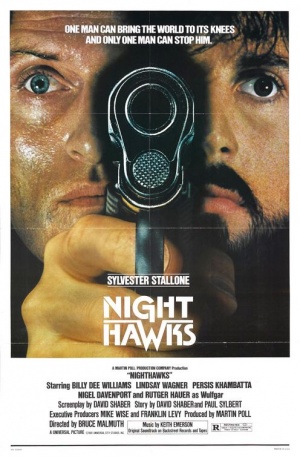
Deke, you must realize we’re not heroes, we’re victims.
“It was a little bit ahead of its time in that I was dealing with urban terrorism,” Sylvester Stallone said of Nighthawks in a 1993 Entertainment Weekly interview. “Now, with the World Trade Center, it’s happening. At the time, people couldn’t relate to it, and the studio [Universal] didn’t believe in it.”
Rightfully so, in 1981, a terrorist attack on American soil was unthinkable, and Nighthawks was intended as a fast-paced action-thriller which played on what would happen if such grave matters occurred. However, the hostage crisis in Iran had just recently come to an end, and it was only mere days before Nighthawks’ April release that John Hickley Jr. attempted to assassinate President Reagan, who had only been inaugurated two months prior. Sure, Rutger Hauer and Persis Khambatta had not grabbed New York City by the balls, but these were events that had struck a nerve with the American public, and it was enough for Nighthawks to hit too close to home with audiences, and as such, it didn’t set the box office on fire like the first two Rocky movies had.
Nighthawks is a curious and brilliant beast as a time capsule of the era it was made. In 1981, cinema had still possessed the raw edginess of 70’s filmmaking, as evidenced in films like Raging Bull and Cutter’s Way which are technically 70’s films trapped in the early 80’s. Nighthawks, lest we forget, was originally intended as a third French Connection film with Popeye Doyle facing off against these sorts of urban guerrillas, who are, in the much-quoted words of the Joker, trying to “introduce a little anarchy.”

The intent, I’m sure, of this was to pit a hard-edged cop like Popeye or Deke DaSilva—lawmen usually used to street drug busts and related cases—against a greater threat, a terrorist threat much like the killings in Munich at the 1972 Olympics or the plotted Super Bowl bombing that the Palestinians and Bruce Dern carry out in the climax of Frankenheimer’s Black Sunday.
DaSilva and Fox are assigned to an elite counterterrorist unit in the NYPD. Basically, it’s CTU from 24 in a skuzzy basement. This is where we meet Nigel Davenport’s character, Interpol agent Peter Hartman, who’s been tracking Wulfgar and Shakka through Europe and now the United States. Hartman’s ideologies are of the sort of indiscriminate, shoot-to-kill “by any means necessary” philosophy—something that became immensely true of our role in counter-terrorism in Afghanistan and Iraq. Deke balks at Hartman’s extreme tactics of doing the job.
Terrorists “make you live in fear,” Hartman tells Deke. “You have no idea of the extent of the underground in your own city, do you? That’s the technique of terror.”
Hartman reminds Deke of the fact that he had 52 registered kills, to which Deke strongly retorts that those were casualties in Vietnam and not street kills. Nevertheless, Deke views the ideology as unjust—war is war, and he refuses to apply his knowledge from Vietnam to risking the city and himself—and surely, following such guidelines—in this case, Hartman’s fight-fire-with-fire philosophy—would only make matters worse.
It’s these ethical questions posed by Nighthawks that truly made the film ahead of its time. After the September 11 attacks, we went into Afghanistan, essentially, for justice, and when the Iraq War commenced in March 2003, the military and enemy casualties not only included soldiers, but civilians who were caught in the crossfire at the wrong time. It’s exactly this sort of thing that the character of Hartman feels strongly about, and only when Fox is attacked by Wulfgar does he realize that Hartman’s lectures were right, that Deke “should’ve taken that shot,” not only is this a plot point which sets the climactic events in motion, it’s a wakeup call for Deke that he simply cannot be streetwise to outsmart Wulfgar and Shakka, but that he must, indeed take the “by any means necessary” approach Malcolm X had popularized years earlier and which Hartman implicitly states is the only true way to become the monsters, to scare the monsters more than they have scared us.
In many movies since Nighthawks, this is a solution that is the last and only resort to violence. Gandhi and Dr. Martin Luther King Jr. found success against oppressors peacefully, but it was not without a share of bloodshed. Fighting violence with violence is something that the Bush administration was profusely attacked for, but the sad truth is that we may not be able to exist without violence. The Die Hard series basically popularized terrorism in action movies, even when, like the original, they’re thieves in terrorists’ clothing. Nevertheless, as soon as McClane sees Takagi buy it, there is no option but “shoot to kill.” In the sequels, whenever he ends up being the wrong man at the wrong place at the wrong time, bureaucracy can’t work. The mission of these people are ruthless, having their own code and agenda in the same way that Wulfgar and Shakka grab Manhattan by the throat.

The scenario presented in Nighthawks has an eerie resonance today.
McClane and Deke DaSilva are very similar characters at heart—both determined, hard-edged cops who can’t fathom the nature of the scenario at first, and who are forced to go over the line to keep the peace. Since the 1980’s, terrorism has become something that federal law enforcement is more likely to take charge of, and the advances we’ve had in technology and intelligence have made us more aware of the world around us, Many live on the edge and in fear of another tragedy, and Nighthawks was made as a thriller with an eye to this growing concern in the world, a hypothetical situation at the very least. Three decades and countless other films later, Nighthawks’ scenario of terrorist attacks on American soil aren’t just a cheap cautionary tale with a preachy “This could happen to us!” message and a group of modern knights protecting the metropolitan kingdom*. These are the seeds of something real, and Nighthawks’ gritty strength still hits hard.
* – What I’m referring to here is the sort of jingoistic fantasy that Cannon loved to do so much in the 80’s with Invasion USA and The Delta Force, in only the way Menahem Golan could cheaply thrill audiences with its loud stereotypes, nefarious bad guys, and exploitation of offenses ripped from the headlines.